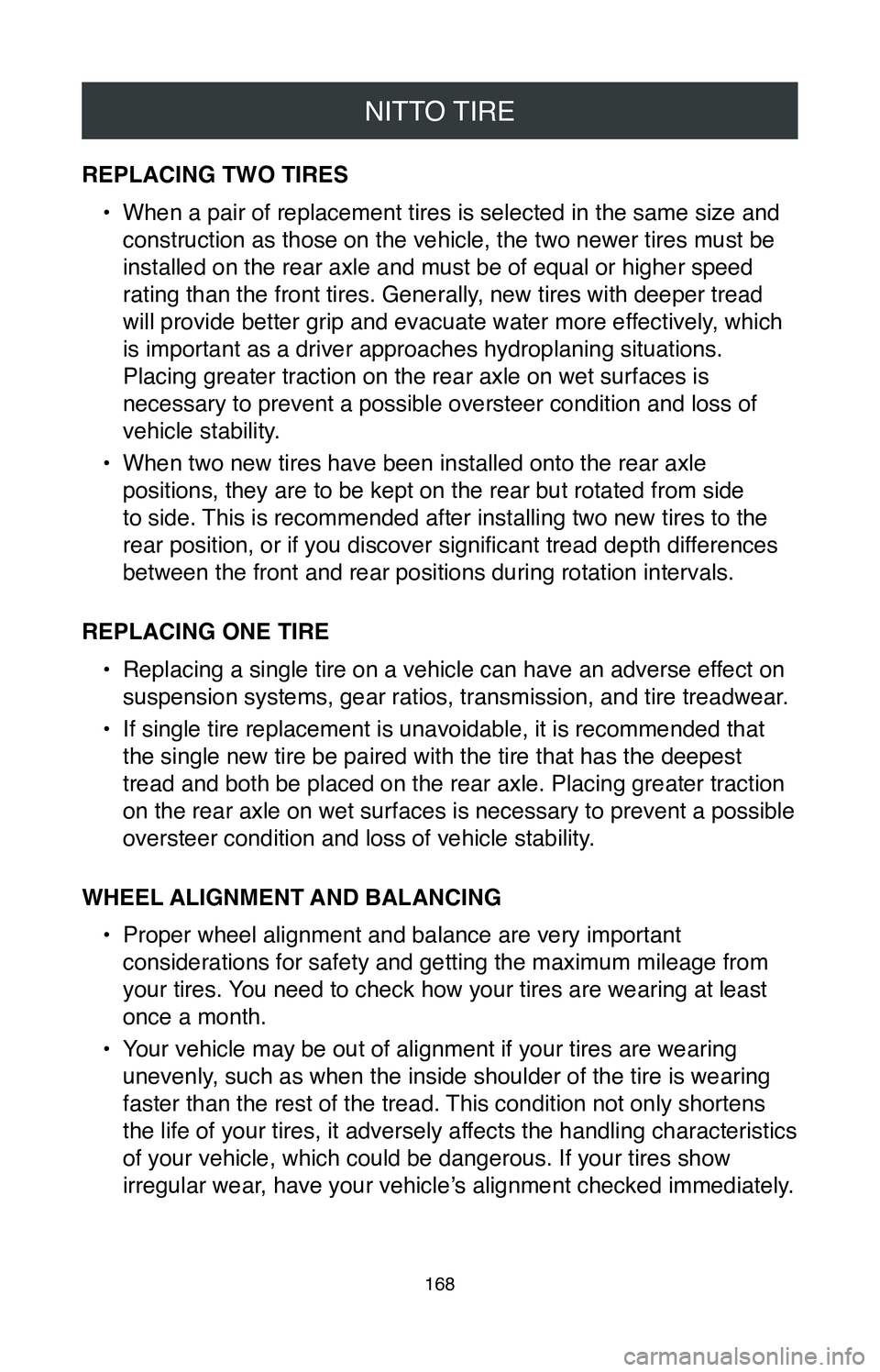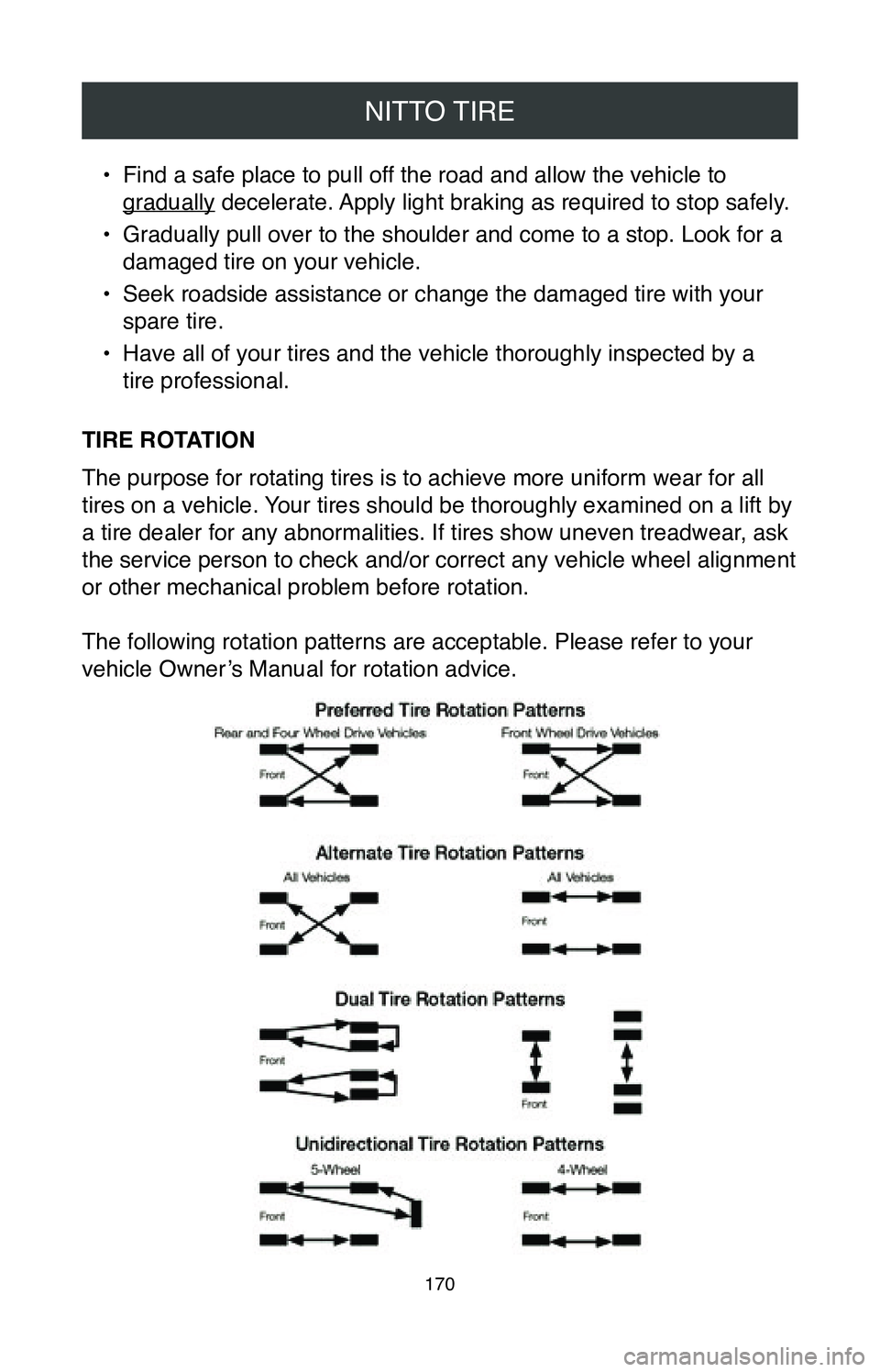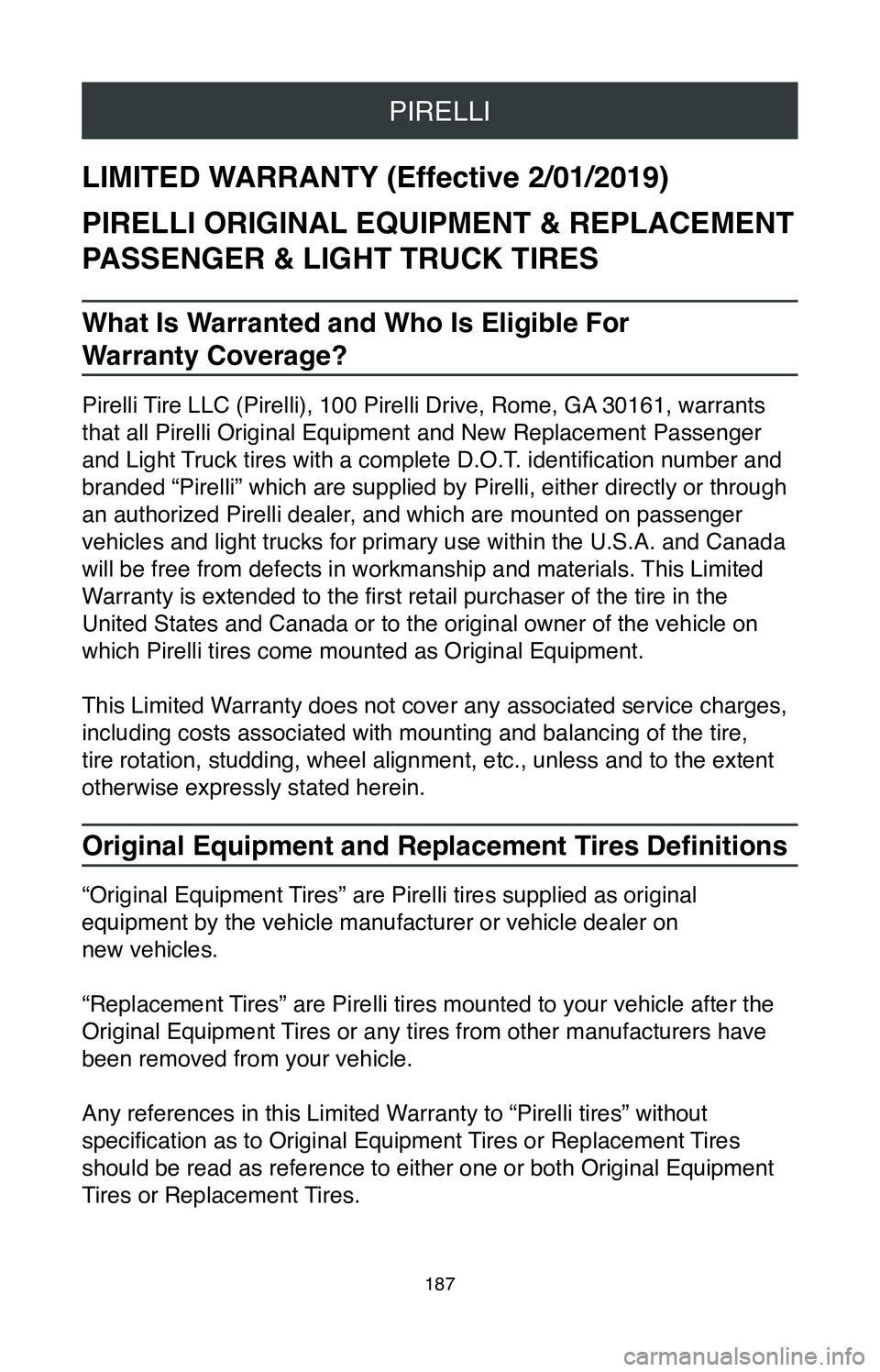2020 TOYOTA AVALON wheel
[x] Cancel search: wheelPage 170 of 260

NITTO TIRE
168
REPLACING TWO TIRES•
When a pair of replacement tires is selected in the same size and
construction as those on the vehicle, the two newer tires must be
installed on the rear axle and must be of equal or higher speed
rating than the front tires. Generally, new tires with deeper tread
will provide better grip and evacuate water more effectively, which
is important as a driver approaches hydroplaning situations.
Placing greater traction on the rear axle on wet surfaces is
necessary to prevent a possible oversteer condition and loss of
vehicle stability.
•
When two new tires have been installed onto the rear axle
positions, they are to be kept on the rear but rotated from side
to side. This is recommended after installing two new tires to the
rear position, or if you discover significant tread depth differences
between the front and rear positions during rotation intervals.
REPLACING ONE TIRE •
Replacing a single tire on a vehicle can have an adverse effect on
suspension systems, gear ratios, transmission, and tire treadwear.
•
If single tire replacement is unavoidable, it is recommended that
the single new tire be paired with the tire that has the deepest
tread and both be placed on the rear axle. Placing greater traction
on the rear axle on wet surfaces is necessary to prevent a possible
oversteer condition and loss of vehicle stability.
WHEEL ALIGNMENT AND BALANCING •
Proper wheel alignment and balance are very important
considerations for safety and getting the maximum mileage from
your tires. You need to check how your tires are wearing at least
once a month.
•
Your vehicle may be out of alignment if your tires are wearing
unevenly, such as when the inside shoulder of the tire is wearing
faster than the rest of the tread. This condition not only shortens
the life of your tires, it adversely affects the handling characteristics
of your vehicle, which could be dangerous. If your tires show
irregular wear, have your vehicle’s alignment checked immediately.
Page 171 of 260

NITTO TIRE
169
TIRE WEAR – VISUAL CHECK
If you experience a blowout or a sudden tire failure, the following
information should be helpful:•
When the tire failure occurs, you may hear a loud noise, or feel a
vibration, and/or the vehicle may pull toward the side of the failed
tire. Do not abruptly brake or turn.
•
Maintain steady pressure on the accelerator pedal.
•
Hold the steering wheel firmly and steer to maintain your
lane position.
Page 172 of 260

NITTO TIRE
170
• Find a safe place to pull off the road and allow the vehicle to
gradually decelerate. Apply light braking as required to stop safely.
•
Gradually pull over to the shoulder and come to a stop. Look for a
damaged tire on your vehicle.
•
Seek roadside assistance or change the damaged tire with your
spare tire.
•
Have all of your tires and the vehicle thoroughly inspected by a
tire professional.
TIRE ROTATION
The purpose for rotating tires is to achieve more uniform wear for all
tires on a vehicle. Your tires should be thoroughly examined on a lift by
a tire dealer for any abnormalities. If tires show uneven treadwear, ask
the service person to check and/or correct any vehicle wheel alignment
or other mechanical problem before rotation.
The following rotation patterns are acceptable. Please refer to your
vehicle Owner’s Manual for rotation advice.
Page 173 of 260

NITTO TIRE
171
Full-size spare tires (not temporary spares) of the same size,
construction, and speed rating may be used in a five-tire
rotation pattern.
After rotation, check the inflation pressure of all the tires. The front
and rear tire pressures may vary according to the vehicle
manufacturer’s specifications.
Remember to follow your vehicle Owner’s Manual for tire rotation
intervals. Your Limited Warranty recommends Nitto brand tires to be
rotated as follows:
•
Every 3,500 miles or less for high performance (low profile) tires.
•
Every 7,500 miles or less for standard passenger and light
truck tires.
More frequent rotation or a thorough vehicle inspection may be
necessary if, upon inspection, irregular or erratic treadwear is
beginning to appear.
It is important to remember the following: •
These tire rotation recommendations do not take into account
different tire and construction types mixed on the vehicle.
•
Some tires cannot be rotated in the manner described. Such tires
include unidirectional tires. Unidirectional tread patterns must be
rotated front-to-rear only so that the direction of revolution does
not change.
•
Some vehicles are designed with different tire sizes on the front
and rear axles. Normally, such combinations will not allow rotation.
Prior to rotating, consult the vehicle Owner’s Manual.
•
For vehicles with dual rear wheels, see the vehicle Owner’s
Manual for the vehicle manufacturer’s procedures. If your vehicle
Owner’s Manual is not available, please contact the vehicle
manufacturer.
•
Some vehicles are equipped with wheels that limit the choice of
rotation pattern. Consult the vehicle Owner’s Manual.
•
Do not include temporary spare tires in the rotation pattern.
However, if your spare tire is the same size and type as a road tire
(for LT tires of the same size, type, and load rating), it should be
Page 182 of 260

NITTO TIRE
180
It is not recommended that any light truck be operated at speeds in
excess of legal limits. However, if it is anticipated that sustained driving
at speeds in excess of 65 mph may be required, then the following
adjustments or recommendations should be followed:•
At speeds from 66 mph through 75 mph, cold inflation pressure
must be increased 10 psi above the recommended pressures for
the load being carried.
•
Do not exceed the maximum inflation pressure of the wheel (all
wheels have maximum allowable inflation pressures).
Replacement Tires for Light Trucks – P-Metric vs LT-Truck
Tire installers should exercise extreme caution when replacing tires on
light trucks.
The maximum load capacity stamped on the sidewall of a P-metric tire
is reduced by a factor of 1.1 when used on a light truck, a sport utilit\
y
vehicle, or a trailer.
Page 186 of 260

NITTO TIRE
184
• Treadwear - The treadwear grade is a comparative rating based
on the wear rate of the tire tested under controlled conditions on
a specified government test track. For example, a tire graded
200 would wear twice as long on the government course as a
tire graded 100. It is wrong to link treadwear grades with your
projected tire mileage. The relative performance of the tires
depends upon the actual conditions of their use and may vary
due to driving habits, service practices, differences in road
characteristics, and climate.
•
Traction - The traction grades from highest to lowest are AA, A, B,
and C, and they represent the tire’s ability to stop on wet pavement
as measured under controlled conditions on specified government
test surfaces of asphalt and concrete.
• Temperature - The temperature grades are A (the highest), B, and
C, representing the tire’s resistance to the generation of heat and
its ability to dissipate heat when tested under controlled conditions
on a specified indoor laboratory test wheel. Sustained high
temperatures can cause the materials of the tire to degenerate and
reduce tire life, and excessive temperature can lead to sudden tire
failure. The grade C corresponds to a level of performance that all
passenger car tires must meet under the Federal Motor Vehicle
Safety Standard No. 139. Grades B and A represent higher levels
of performance on the laboratory test wheel than the minimum
required by law.
Page 189 of 260

PIRELLI
187
LIMITED WARRANTY (Effective 2/01/2019)
PIRELLI ORIGINAL EQUIPMENT & REPLACEMENT
PASSENGER & LIGHT TRUCK TIRES
What Is Warranted and Who Is Eligible For
Warranty Coverage?
Pirelli Tire LLC (Pirelli), 100 Pirelli Drive, Rome, GA 30161, warrants
that all Pirelli Original Equipment and New Replacement Passenger
and Light Truck tires with a complete D.O.T. identification number and
branded “Pirelli” which are supplied by Pirelli, either directly o\
r through
an authorized Pirelli dealer, and which are mounted on passenger
vehicles and light trucks for primary use within the U.S.A. and Canada
will be free from defects in workmanship and materials. This Limited
Warranty is extended to the first retail purchaser of the tire in the
United States and Canada or to the original owner of the vehicle on
which Pirelli tires come mounted as Original Equipment.
This Limited Warranty does not cover any associated service charges,
including costs associated with mounting and balancing of the tire,
tire rotation, studding, wheel alignment, etc., unless and to the extent\
otherwise expressly stated herein.
Original Equipment and Replacement Tires Definitions
“Original Equipment Tires” are Pirelli tires supplied as original
equipment by the vehicle manufacturer or vehicle dealer on
new vehicles.
“Replacement Tires” are Pirelli tires mounted to your vehicle after the
Original Equipment Tires or any tires from other manufacturers have
been removed from your vehicle.
Any references in this Limited Warranty to “Pirelli tires” without
specification as to Original Equipment Tires or Replacement Tires
should be read as reference to either one or both Original Equipment
Tires or Replacement Tires.
Page 194 of 260

PIRELLI
192
and Replacement Tires manufactured with Pirelli Run Flat or
PNCS technology.
If a Run Flat or PNCS tire becomes unserviceable due to road hazard
damage within the first year from the date of purchase, or within the
first 2/32” of the original usable tread, whichever occurs first, the Pirelli
tire will be replaced with an identical or comparable tire at no charge \
for the tire to the owner, including mounting and balancing (subject to
applicable limitations).
What Is Not Covered by this Limited Warranty?
• Ride-related claims after the first year of purchase, or after the
first 2/32” of useable tread, whichever comes first. These include,
without limitation, uneven wear due to misalignment, worn
suspension components, mechanical interference and/or improper
inflation, flat spots due to improper transport, improper storage
and/or braking, road irregularities, etc.
•
Irregular wear.
•
Excessive noise emissions.
•
Tires with 2/32” or less tread remaining.
•
Tire damage and surface cracks due to use in low ambient
temperatures (except in winter and all-season Pirelli tires as
defined in the applicable Pirelli Product Catalog).
•
Tire damage due to abuse or misuse, including without limitation:
- improper mounting/dismounting practices, application of
aftermarket wheel protection hardware, abuse, misuse,
or neglect;
- misapplication, including improper fitment, insufficient Speed
Rating, or Load Index, or undersized or oversized tires;
-improper repair, repair not conforming to U.S. Tire
Manufacturers Association standards, or repairs with a self-
vulcanizing plug only or patch only;
- modification by the addition or removal of material or alteration
to change the appearance or performance of the tire;
-recapping, retreading, regrooving or in the studding process;
- tire operation in excess of tire/wheel manufacturers’
specifications and recommendations, including spinning;